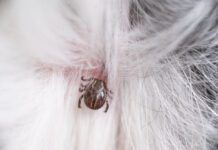Correction:
In the list of WDJ-approved dry foods presented in our February issue, we reported incorrect ranges for the amounts of protein and fat in some of the dry foods made by Dogswell. The products in the company’s Live Free dry food line contain 36% to 40% protein and 14% to 18% fat. The products in Dogswell’s dry Nutrisca line contain 30% to 32% protein and 16% to 18% fat. We regret the errors.
Regarding “Spot the Problem” (WDJ January 2014): Where can I find dosage charts by dog weight, not by brand name, that show the different drugs used for these products? I need to re-visit my choice of treatment.
My 3-year-old Lab became very ill, and now I wonder if it was the Trifexis we use. The vet kept asking if we gave her anything “different” than usual. The answer was “No.” She is 65 lbs, and the vet will only sell us the BROWN 65-120 lb strength. I really think I am over-dosing!
Susan Wright
Via email
If your dog has become ill within a week of being treated with either a topical or oral flea/tick/heartworm prevention drug or pesticide, we would recommend not using that drug or pesticide again, nor any preparation that included the same active ingredients as the one that caused the problem.
As the article suggested, we also would recommend using the smallest dose that would adequately protect your dog. When your dog’s weight is right on the line between products with different dosages, we’d recommend using the lower dosage. And we’d discontinue using the services of any veterinarian who wouldn’t be more sensitive to the possibility that the Trifexis, particularly at a potentially too-high dose, could have caused your Lab’s illness.
Are dog foods required to meet AAFCO standards/guidelines in order for you to include them in your list of recommended foods (“Dried and True,” WDJ February 2014)? I understand the difference between “meets AAFCO standards” and “AAFCO certified.”
Name withheld
via email
Only foods that are “complete and balanced” as per the AAFCO guidelines appear on our list of “approved foods.” But you may misunderstand the terms you referenced.
AAFCO (the Association of American Feed Control Officials) does not “certify” any foods; it is not a certifying or inspecting entity, but rather, an advisory group that develops model regulations that are, almost uniformly, adopted by and used by each individual state. Dog foods are regulated by state laws and subject to inspection by state feed control officials. Each of the United States has adopted the recommendations as to the definitions of “complete and balanced” that have been developed by AAFCO.
In order to use the phrase “complete and balanced” on its label, a product must have met one of two possible sets of requirements (both of which were developed by AAFCO), and it needs to use a specific phrase that describes which of the requirements it met. It will either state that, “(Name of product) is formulated to meet the nutritional levels established by the AAFCO nutrient profiles,” or “Animal feeding tests using AAFCO procedures substantiate that (product name) provides complete and balanced nutrition for (life stage).” Again, all of the products we include on our lists have met one of these requirements.
We’ve published many articles about AAFCO and the various ways that foods qualify as “complete and balanced,” including articles that discuss the problems and strengths of each method of qualification. Use the “search” feature on wholedogjournal.com for a list of relevant articles.
Regarding the article “It’s in the Bag” (February 2014) you recommend storing food in the original bag, and the bag in a container.
I need some clarification. I live in the southwest; mice and cockroaches are prevalent in my area. We need a “critter proof” container and fresh dog food! How truly safe is the dog food in a plastic container, while remaining in its bag? (After opening the bag, I fold down and clip the bag prior to storing.) I am aware of BPA and other possible toxin releases. The plastic containers are hard plastic.
Sharon Maughan
Albuquerque, NM
As long as you leave the food in the bag, it’s protected from any container you put the bag in. Pet food bags are designed to protect the food and recent innovations in packaging have made them safer and more impermeable than ever. The potential for contaminating the dog food lies in the practice of dumping the food directly into the plastic container without its bag. The fat in dog food can chemically interact with many plastics and facilitate the transfer of chemicals from the plastic into the food. We recommend keeping dry dog food in its bag (even if you use supposedly “safe” plastic containers).
I have four Dobermans and I walk them every day. I consider them my friends and exercise machines.
When Sony invented the Walkman, particularly the Walkman radio, my dog walking was taken to new heights. I could keep abreast of the news. I would walk the dogs and the radio up and down Signal Hill, the most easterly city in North America, every morning, often before dawn. Life was good. The dogs and I were happy.
Then my wife read in WDJ that wearing headphones while dog walking was bad, so I stopped. Life became, well, dull. I see today in your March 2014 issue (“Walk On!”) in which you repeat your advice: “No headphones. Ever.”
What if I give each dog his or her own headphones? Would that solve the problem? Thanks for an otherwise fine magazine.
Clifford Grinling
St. John’s, Newfoundland
So sorry to make your walks so dull, but it’s a safety issue. Wouldn’t you rather hear that runaway truck behind you, or the shouts of “Watch out for the crazed moose!”? You’re welcome.




